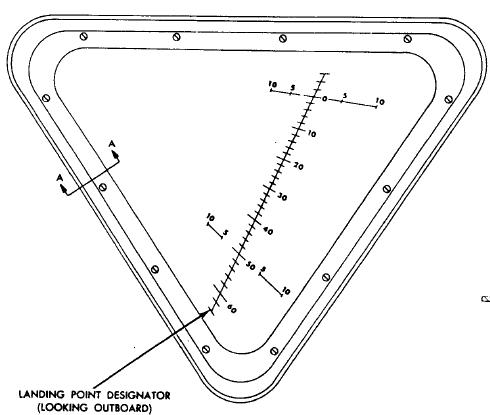 The landing point designator was consisting in a scale displayed on the window which was allowing the astronaut to indicate the desired landing spot to the computer, which was then maneuvering to reach this desired landing spot. So, how was it working? 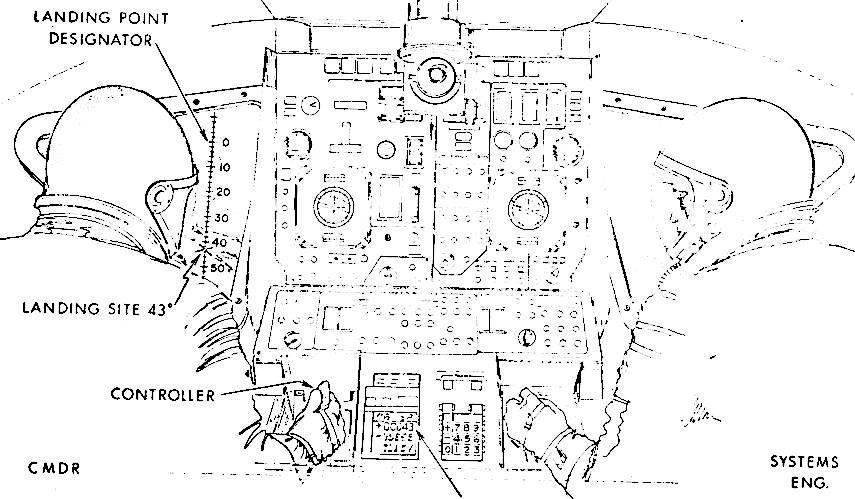 The astronaut looking through the window was spotting the mark of the scale which was at the same height as the desired landing spot; the second astronaut was reading the current mark of the computer and saying it to the first astronaut; the first astronaut was then comparing his own mark with the computer's mark, and making a succession of actions (as many as the observed difference) on the hand-controller to tell the computer to correct its trajectory, in order to make it fit with the desired landing spot. So, what are the problems with this system? The first problem is that the mark that the first astronaut was reading was depending on the distance he was from the window. And it was also depending on the height of the astronaut relatively to the window; it means that a tall astronaut or a small astronaut will not see the same mark for the same landing spot. Now, if we ignore these problems, what is the next problem? The second astronaut has indicated the mark of the computer, but the first astronaut sees that the landing spot is on a mark which is lower than the computer's mark. So the first astronaut makes a succession of actions on the hand-controller corresponding to the difference. But, it takes time to make this succession of actions, time for the computer to take them into account, time for the second astronaut to read the computer's mark, time for the second astronaut to tell this mark to the first astronaut, and time for the first astronaut to record it. Now the computer's mark is the same as the astronaut's mark in the previous step, but meanwhile the LM has moved forward, and the first astronaut sees that the landing spot is on a mark which is lower than the previous one. So, the first astronaut makes a succession of actions on the hand-controller to tell the computer to correct its trajectory again. And so on, at the next step, same comment again. The first astronaut has to correct again the computer's trajectory. So, with this system, because of the succession of delays, the computer will systematically be late on what the first astronaut reads; not only the astronauts keep correcting the LM's trajectory, but also, because the computer is always late at adjusting its trajectory, it will miss the landing spot and pass it without stopping on it.  it means that this landing point designator is inaccurate, unpractical, and imprecise. Very well, you are going to say, it is easy to criticize, but criticism is vain if I don't propose a better system. If I don't, may be that this system, in spite of its flaws, was the best one which still was available. But I do propose a better system. What I propose is that the astronaut looks through an optical system, and aligns the center of the reticle of this optical system with the landing spot, and, when he has the landing spot on the reticle's center, he just clicks a button to signal the position of the landing spot to the computer. Very well, you are going to say, but, after he has pressed the button, he still has to input the orientation angles of the optical system to the computer, and this takes time; by the time that the astronaut has finished inputting these angles, the LM has moved, and the reticle is no more on the landing spot, but a completely different place instead. So, it does not seem better than the landing point designator, may be even worse, for it takes more time to input angles, probably more time than to make actions on a hand controller, and to read a mark on the computer. Sure, if the astronaut had to proceed that way. But the wheels that the astronaut turns to orient the optical system would send odometer pulses to the computer which would allow it to automatically know how the astronaut orients the optical system; sensors would indicate in which direction the wheels are turned, so that the pulses could be counted either up or down. And don't tell that this technology was not existing, for the speed of the rover was measured by counting odometer pulses generated by the rotation of a wheel. That way, when the astronaut would push the button at the moment that the reticle of the optical system is on the landing spot, the computer would already know at what orientation of the optical system it would correspond, without the astronaut having to tell it by inputting angles on the keyboard. There would be no delay between the acquisition of the astronaut and the acquisition of the computer, or at least quite small, much less than with the landing point designator. |
Another absurdity concerns the way the astronauts were making the alignment with a star when they had to make the alignment of the inertial platform. The optical system had a very large field of view; the astronaut was moving the optical system, not to have the star on the center of the reticle, but just on the field of view of the optical system; then he was turning the optical system twice, one time to align a straight bar along a radius on the star, and a second time to put the star on a spiral It was very imprecise, notably because of the large angle of view of the optical system, and second because the alignment with a spiral was very imprecise, the star appearing on the spiral on a small, but not negligible, range of the adjustment. The right way to make the adjustment would have been to have an optical system with a smaller field of view, and to align the star on the reticle's center. |
 This figure describes the equipment of an astronaut of an Apollo mission.  Near his feet, there are small pockets, a checklist pocket, and a still smaller pocket for scissors. But, how could the astronaut with his heavy equipment and his pressurized gloves take things from these pockets. When I am wearing winter gloves and I want to take out something from a pocket, I have to remove my gloves for I don't succeed to do it with my gloves on; so how could the astronaut remove things from his pockets with his pressurized gloves which are still less easy to manipulate than my winter gloves? Furthermore, with his suit, the astronaut had much difficulty to reach his feet, for he could not fold his body like we can without an astronaut suit. |
 On his abdomen the astronaut had connectors which allowed him to connect his internal water, oxygen and waste system to a portable life support system (PLSS) contained in the lower part of his backpack and also to connect to the oxygen purge system (OPS) contained in the upper part of his backpack. 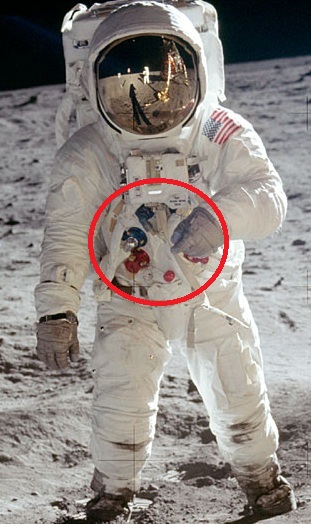 Normally the astronaut should always have his cables connected with the PLSS and the OPS.  But, if on the photo AS11-40-5903 (left - the one on which Buzz appears with his arm folded) the water connector is connected, such is not the case on the photo AS17-140-21391 (right), on which it appears that the water connector is not connected! 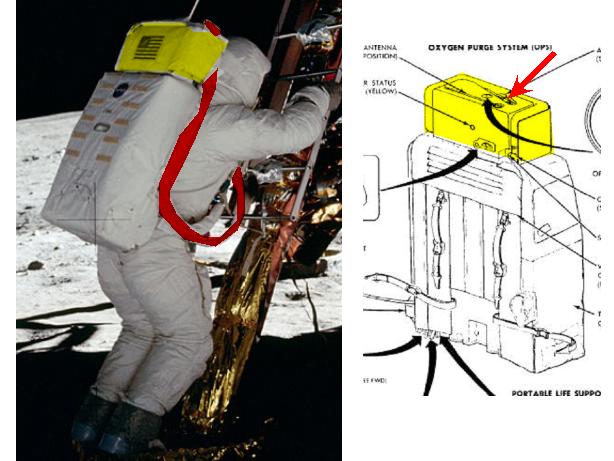 Now they want to make us believe that the cable I have colored in red could be stowed at the place I have indicated with a red arrow on the right! How could this cable hold inside the OPS? it would have taken all the available space! there probably was little space left for the OPS itself! |
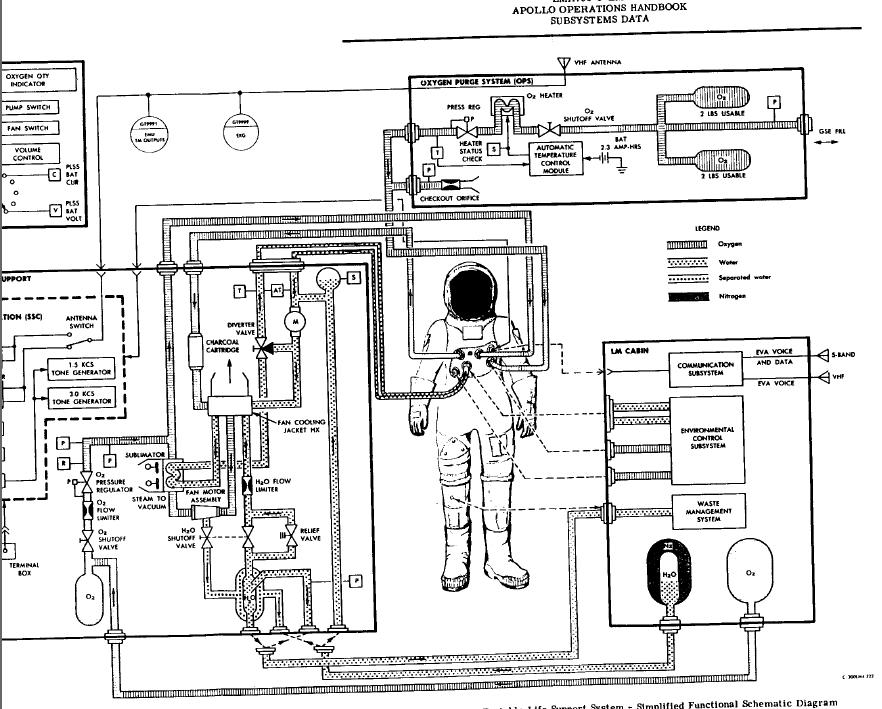 This figure describes the PLSS (lower part of the backpack -left of the figure) and the OPS (upper part of the backpack - top right of the figure) with their connections to the astronaut. The PLSS can also be connected to the reserve tanks of the LM cabin (bottom right of the figure). On this animation, I show the flow of water inside the PLSS; the red flow shows the connection with the reserve tank of the LM cabin, and the orange flow the flow inside the PLSS and going though the internal system of the astronaut. On this animation, I show the flow of oxygen inside the PLSS: The red flow shows the connection with the reserve tank of the LM cabin, and the orange flow the flow inside the PLSS and going through the internal system of the astronaut.  The flow of oxygen is controlled with an automatic pressure regulator (circled in red) which prevents the pressure from going too high. But, in case that this pressure regulator would fail, the astronaut has the possibility to manually shut a valve (circled in violet) with a switch available on the backpack. 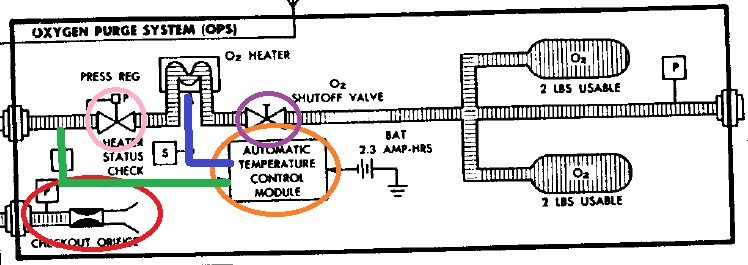 This is the schema of the OPS (Oxygen purge system). The first surprising thing is this "checkout orifice" which gives on the open. Then there is an automatic temperature control module, I have circled in orange, which is supposed to control a heater; you'll tell me that there is no wonder that an automatic temperature control regulates a heater. Certainly, but it all depends on what temperature allows to make the regulation; if this temperature comes from the heater itself, then no problem; but here the temperature is taken before even the pressure regulator, and this temperature may be very different from the temperature in the heater. Then, like in the PSSL, there is an automatic pressure regulator (circled in pink) which prevents the oxygen pressure from going too high. And, like in the PSSL, in case that this pressure regulator would fail, the astronaut also has the possibility to manually shut a valve (circled in violet).  And that's where it becomes comical: the gauge which allows to check the oxygen pressure in the OPS is located on the top and back of the top of the backpack; there is no way that the astronaut can check this gauge, and he cannot even ask the other astronaut to check it, for it also not visible for the other astronaut. There are three small valves located under the PLSS (circled in orange): - H2O DIVERTER VALVE - PRIMARY O2 SHUTOFF VALVE - H2O SHUTOFF AND RELIEF VALVE Normally there is an automatic regulation. For instance there are two valves "O2 pressure regulator" and "O2 shutoff valve" which are serially mounted; the second one is normally open, for the first one is automatically commanded, and automatically closes when the pressure goes beyond a given value. But it may happen that the automatic valve has a problem and ceases to normally work (for instance if the battery has a problem); in that case, it no more closes when it should, and the astronaut may then manually close the Primary O2 shutoff valve in order to prevent the overpressure problem, what the automatic valve can no more do. But, if the astronaut realizes there is a problem, how do you want him to accede to this valve he can't even see?  On the bottom of his torso, the astronaut had a CO2 purge system. In order to start the purge, the astronaut had to remove a pin circled in green, and depress a tab circled in yellow. But this pin would have been difficult to remove with the pressurized gloves, and that's why this pin was attached to a big ball (circled in orange) that the astronaut could easily grab and pull to remove the pin.  On this close-up of Apollo photo, the CO2 purge system has been circled in red, and the ball that the astronaut had to pull to remove the pin has been circled in orange.  And that's where the absurdity begins. When the purge was over, the astronaut was supposed to reinsert the pin to stop the purge. But the ball attached to the pin was only allowing to remove it, it was no use to reinsert it into its hole. Reinserting the pin into its hole was practically impossible with the big pressurized gloves. That means that the engineers had provided an easy way to start the purge, but nothing to properly stop it at the end of the purge. So why hadn't the engineers provided a more practical system, with for instance a lever with two positions, one closing the hole, and the other one opening the hole, so that it would be as easy to close the hole as to open it? Because, once again, everything had to be unpractical and illogical in Apollo! 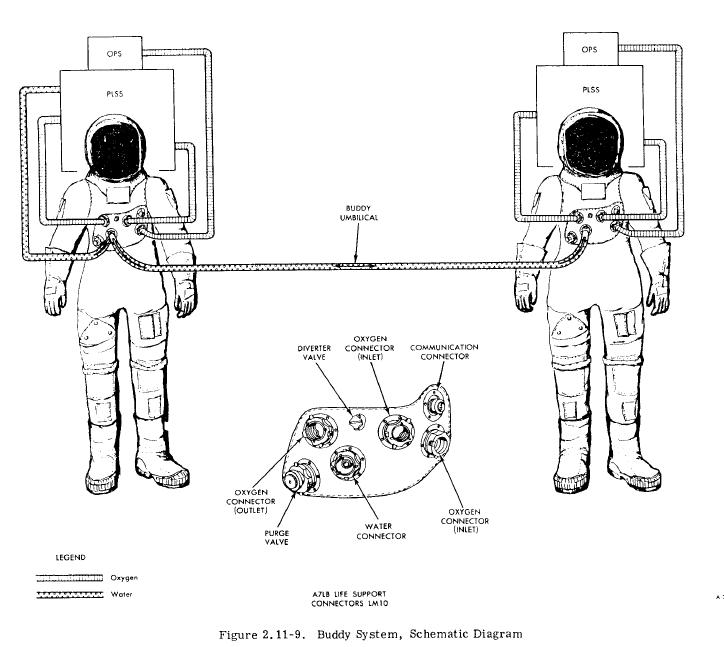 In case that the water flow fails for an astronaut, he can share the water of the other astronaut with a connection which is shown on this schema, and called "buddy system" (water or oxygen). They say that this connection system allows to increase the EVA backpack limit to 2 kilometers. But it makes no sense, for, if an astronaut takes his water from the other astronaut, he will drain out twice faster the water reserve of the other astronaut than the latter would if he was alone to use it. Furthermore, how do they make to connect this buddy system without letting the water or oxygen escape? |
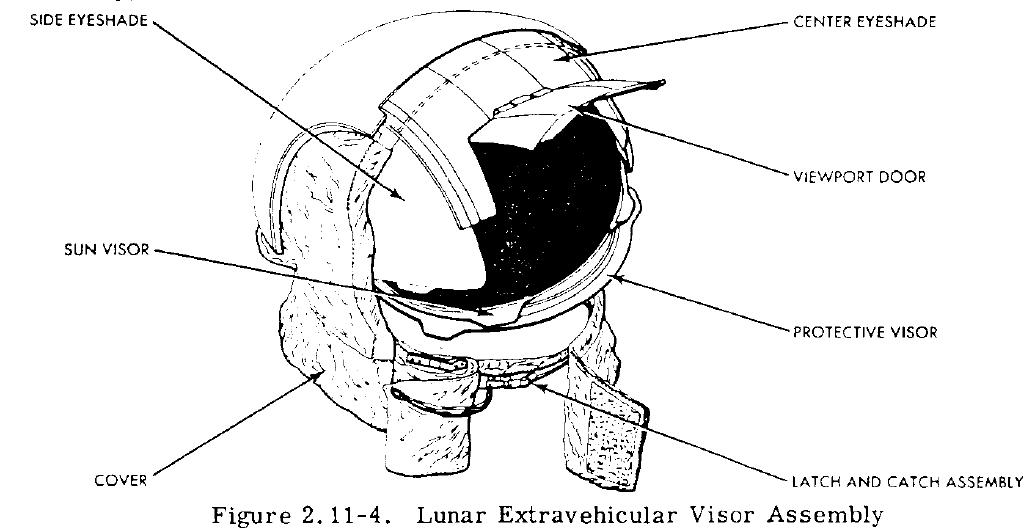 The astronaut had shades he could pull on his helmet, but how did he manage to pull them with his pressurized gloves? |
 This schema shows the electrical connectors of the EMU. What is surprising is the duplicate connections; the various signals are connected several times on these connectors; why isn't once enough? |
 This figure shows the restraint system which was allowing the astronaut to remain on the platform in spite of the moves of the craft. The problem with this restraint system is that it is not centered; when the astronaut pulls on it because he loses his balance, instead of maintaining him on the center of the platform, this system pulls him on the left and thus contributes to make him lose his balance. |
 In order to realize the alignment of the two crafts before docking, which requires a perfect alignment, the astronauts had an optical alignment sight system. This system was consisting in aligning a reticle generated by a collimating lens system with a target mounted on the other craft. The reticle could detect a variation of roll... ... or a variation of yaw... ...or a variation of pitch.  When the reticle was perfectly aligned with the target mounted on the other craft, the alignment of the two crafts was perfect, and the docking was possible. 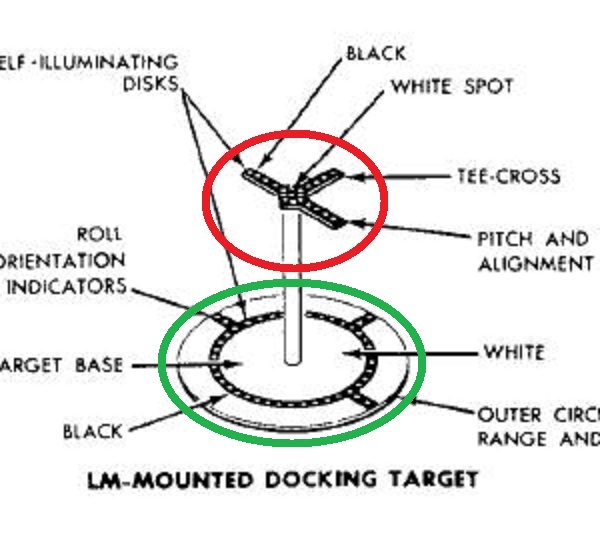 But, over the normal target (circled in green), they had mounted a cross (circled in red), which in fact had no other use than hinder the alignment of the COAS. 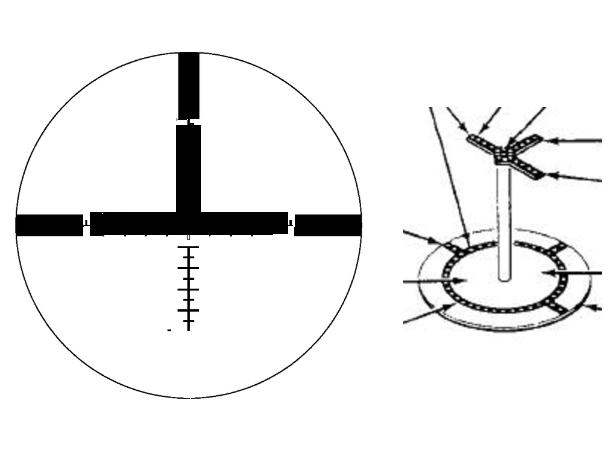 Indeed, when the reticle was close to good alignment, the added cross was coming in superposition with the reticle and making it less visible, thus preventing from making a perfect alignment! |
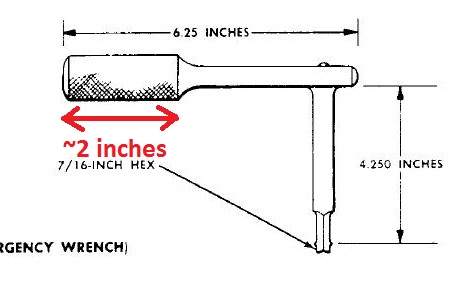 This figure shows an emergency wrench the astronauts could use to open the CM hatch from outside. The problem is that, if we refer to the given sizes, the handle has a length of around two inches! It is really short for a handle, especially when you must handle it with pressurized gloves! |
 This figure shows the modularized stowage assembly (MESA). I have circled in red the TV tripod.  Is it really the same tripod? |
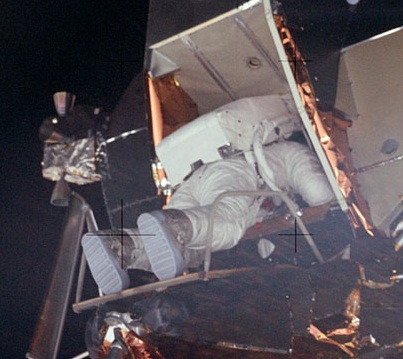 When the astronaut was getting out of the hatch, he first was crawling on the platform, hauling himself with his hands.  Then he was hopping on the ladder. 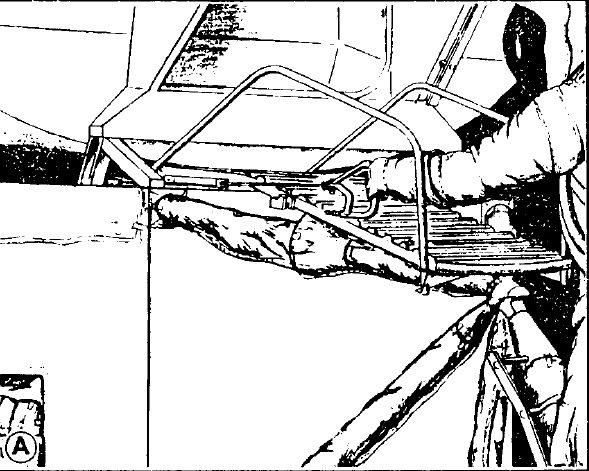 It is only when he was on the top of the ladder that he was pulling a ring to deploy the MESA. Only from this moment the camera which was in the MESA was starting to film. So, logically, the astronaut should appear on the video soon after the camera has started to film. 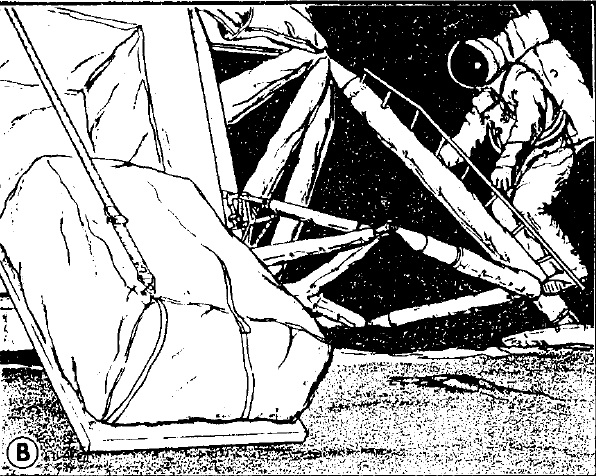 On the documentation, the MESA is still wrapped after it is deployed. So we wonder how the camera could film. We'll suppose that was a hole in the wrapping which was allowing the camera to film. In spite of the fact that the astronaut should appear on the video soon after the camera has started to film, he sometimes only appears several minutes after the camera has started filming, for instance in Apollo 12 and Apollo 15. What is the astronaut doing during all this time? Taking a nap? |
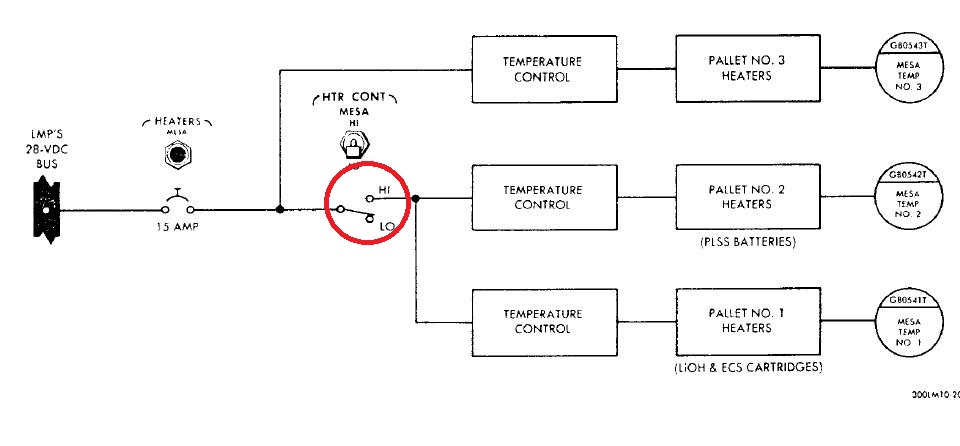 This is the schema of the heater circuits of the MESA. If the temperature control of the heaters of the Pallet No 3 is permanently connected, the temperature control of the heaters of the heaters of the Pallets No 1 and No 2 are connected only if a switch is in a "Hi" position. But why? Why aren't they permanently connected like for the Pallet No 3? And on what ground is the switch connected on the "Hi" or "Lo" position? |
 This figure shows that the helmets could be stowed over the cover of the ascent engine. I am not sure it is the right place to put the helmets on! 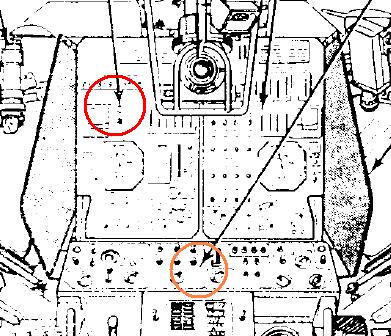 When the lunar probes were coming in contact with the lunar ground, two lamps were going on to warn the astronauts that the lunar ground was close and that the descent engine had to be shut off. These lamps were lit in the same time for a reason of redundancy, in case that one would fail. But these two lamps were not mounted on the same panel, they were mounted on two different panels. So, if the astronaut checking the lamps wanted to benefit of the redundancy, he had to alternately check the two lamps, and, as they were not mounted on the same panel, he had to constantly move his head from a panel to the other in order to check the two lamps, in case one of them would fail. A good way to get a stiff neck! |
 The ALSEP (Apollo lunar surface experiment package) had a handle to carry it, but the problem is that this handle was not centered on the ALSEP. 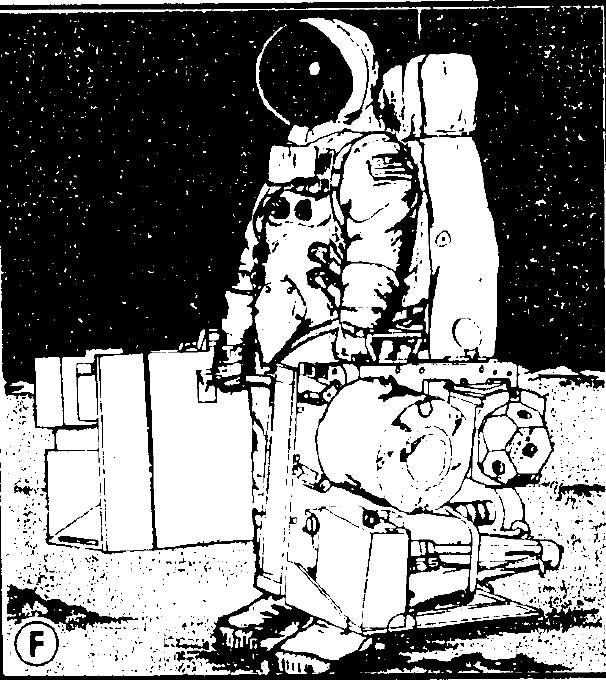 This figure shows an astronaut carrying the ALSEP with its handle, but in fact he could not carry it this way... ...because the ALSEP would swing so that its center of gravity would come on the vertical of the astronaut's hand! This is the consequence that the ALSEP's handle is not centered. |
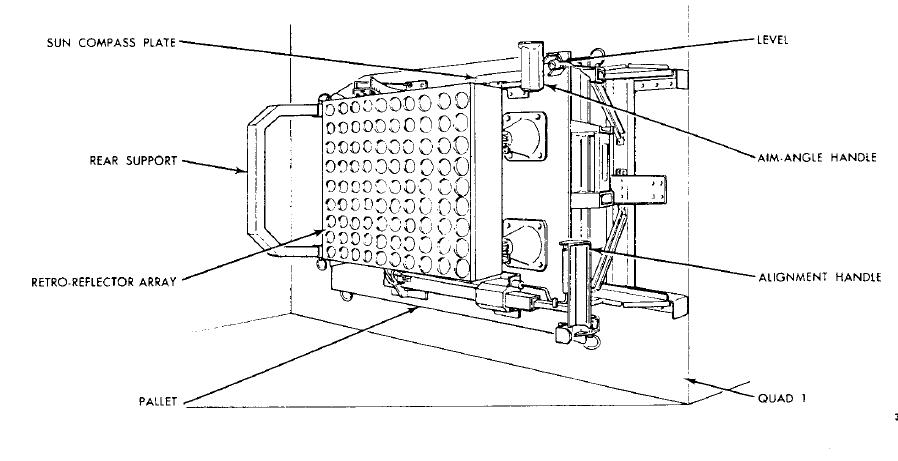 In order to adjust the orientation of the retro-reflectors, the astronauts only had screws, nuts and bolts, nothing practical; yet, with their difficult to manipulate gloves and their reduced angle of view (which was preventing them from looking into the viewfinder of their cameras), having to deal with screws, nuts and bolts was certainly not easy, that's the least to say! 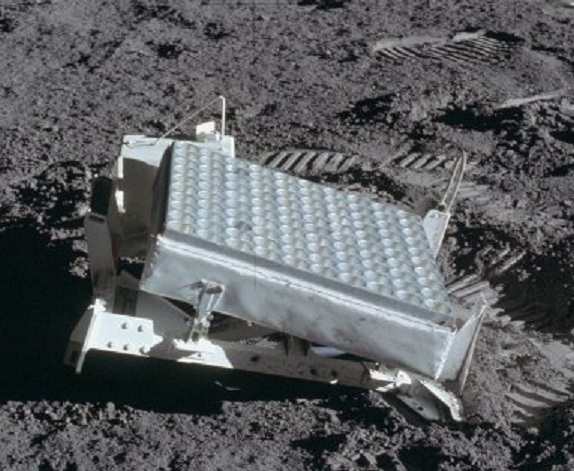 When we look at the retro-reflectors on the photos of the missions, it is obvious that there was nothing to easily adjust them.  It stands for reason that the retro-reflectors should have been equipped with adjustment knobs allowing the astronauts to orient them as easily as possible. Even better, they should have been equipped with radio-commanded orientation systems, so that their orientation could be corrected after the astronauts left for the moon, for it was certainly not easy for the astronauts to know what exact orientation to give them. |
 The ALSEP's power was provided by a radioisotope thermoelectric generator (RTG); in order to make it work, a fuel capsule had to be inserted into the RTG. This fuel capsule was contained in a fuel cask attached to the LM. The astronaut had to extract the fuel capsule from the fuel cask to insert it into the RTG. This figure shows the fuel cask in vertical position as it is attached to the LM.  The astronaut was then unstrapping the top of the cask to put it in horizontal position. But the question I am asking is: How could the cask hold in this horizontal position? What was holding it in this position? |
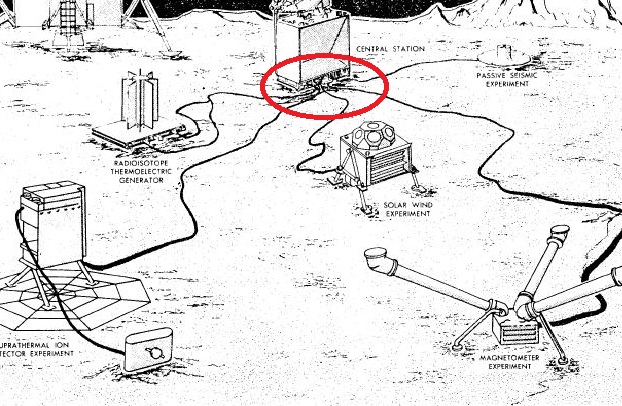 All the elements of the ALSEP were connected by wires to the ALSEP which was transmitting the measures.  But, I be damned if this joke can transmit anything! |
 What follows is about the use of the PLSS in Apollo 12. It is based on a table in the mission report of Apollo 12, at page 8-20. 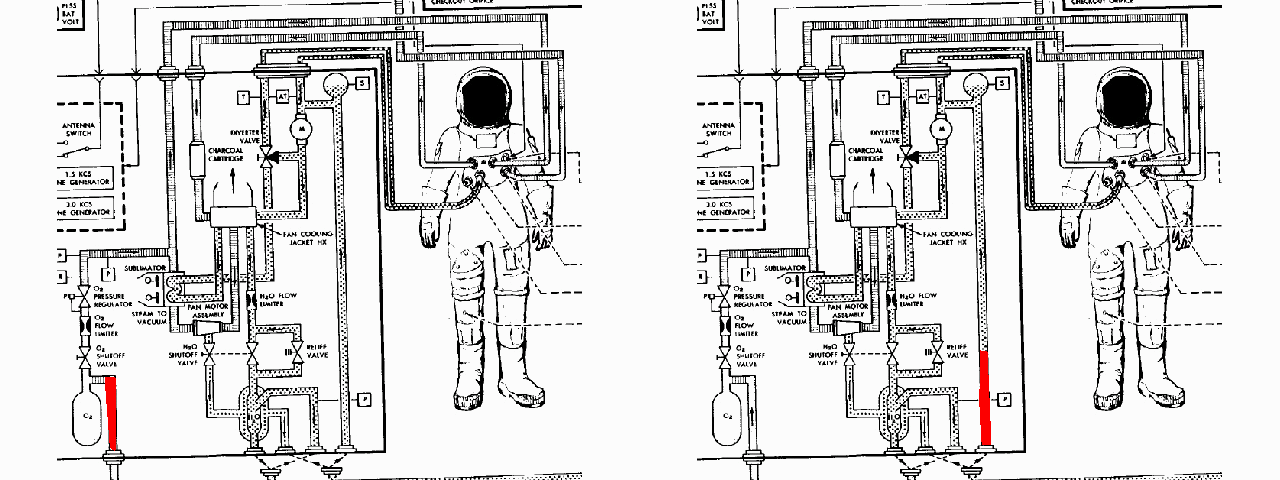 Both for the oxygen and water, electrically commanded automatic valves were allowing to regulate the flow, which means that, the more the astronaut was consuming oxygen and water, and the more also he was using electrical power. This is an important precision for what follows.  The table I have used contains two columns for each astronaut, one indicates the real use, and the other one the predicted use. 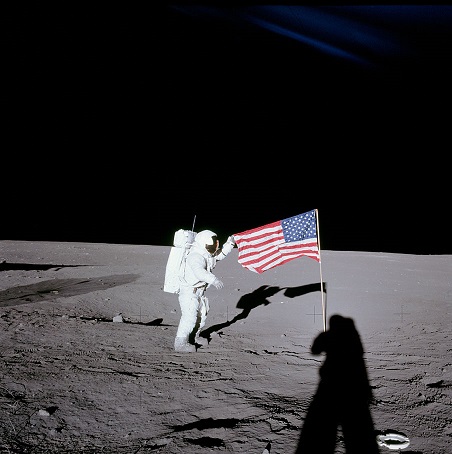 Now, let's examine the data of first EVA.  In first EVA, Conrad has used 0.725 pounds of oxygen, while he was predicted to use 0,873 pounds, so he used less than what was predicted. Al Bean has also used 0.725 pounds of oxygen, while he was also predicted to use 0.873 pounds, so he also used less than what was predicted.  In first EVA, Conrad has used 4.75 pounds of feedwater, while he was predicted to use 5.4 pounds of it. And Al Bean has used 4.69 pounds of feed water, while he was predicted to use 5.2 pounds of it.  Finally, in first EVA, Conrad has used 187 watt-hour of electrical power, while he was predicted to use 130 watt-hour only, which is strange, for, as he used less oxygen and feedwater that what was predicted, he should also have used less electrical power than what was predicted. Al Bean has used 188 watt-hour, slightly more than Conrad, while he has used a little less feedwater.  Now, let's examine the data of second EVA, and that's where the fun begins.  In second EVA, Conrad has used 0.695 pounds of oxygen, while he was predicted to use 0.886 pounds of it, and Al Bean has used 0.720 pounds of oxygen while he was predicted to use 0.849 pounds of it; notice that, while Al bean was predicted to use less oxygen than Conrad, he has instead used more of it.  In second EVA, Conrad has used 3.89 pounds of feedwater, while he was predicted to use 6.2 pounds of it, which means that he has used consistently less oxygen than he was predicted to do. Al Bean has used 4.69 pounds of feedwater, while he was predicted to used 5.8 pounds of it; so he has also used less than predicted, but notice that he has used more feedwater than Conrad while he was predicted to use less of it.  So, it appears that, while Al Bean was predicted to use less oxygen and feedwater than Conrad in second EVA, he has instead used more of it. You'll say that it proves nothing, Al Bean might have been more zealous than predicted, and so might have used more oxygen and feedwater than predicted. But now comes the surprise.  In second EVA, Conrad has used 177 watt-hour of electrical power, while he was predicted to use 130 watt-hour only, and, as he has used less oxygen and feedwater than predicted, he should also have used less electrical power than predicted. And Al Bean has also used 177 watt-hour of electrical power instead of the predicted 133, with the same comment as for Conrad. But the final clue is that Al Bean has used the same electrical power as Conrad, while he has used more oxygen and more feedwater than Conrad did, which means that he should also have used more electrical power! This is a proven incoherence! |
 What follows talks about the use of the PLSS in Apollo 17. I have already talked about the use of it in Apollo 12, and shown anomalies in it. This time, I am going to talk about its use in Apollo 17, and the anomaly I am going to show is quite different from the anomaly I have shown in Apollo 12.  In the handbook of the lunar module, they say this about the PLSS: "The PLSS can operate for 7 hours, depending upon the astronaut's metabolic rate, before the oxygen and feedwater must be replenished, the battery and lithium hydroxide (LiOH) cartridge must be replaced, and condensate discharged."  So, I have inquired about the total duration of the third EVA. It starts with this comment at time 163:33:44: "Cernan: I guess the next thing is to open the hatch, huh?" So, if they are about to open the hatch, it means they already have their backpack on.  The last comment is at time 170:44:46: "Cernan: Hatch is closed. Let's see if I locked it" The LEM cannot be pressurized again before the hatch is locked, so it means that the astronauts still have their backpacks on. The difference of time between the opening and ending comments is 7 hours and 11 minutes. It means that the astronauts have kept their backpacks on beyond the acceptable limit. They should reasonably have exhausted their oxygen, feedwater, and battery.  A table in the mission report of Apollo 17 describes the use of the backpack. I show here its use in the third Eva.  Like for Apollo 12, there are two columns for each astronaut, one is the real use, and the other one is the predicted use.  In this table there is a line about the redline limit; as this information is very important in the demonstration, I must explain what this line is about. In a document about the mission limits, the redline limit is described for the PLSS as the moment that there remains less than 30 minutes of oxygen, feedwater, or battery. It means that, for each item, if the remaining quantity is over the redline limit, there remains more than 30 minutes in the use of it.  This is the information concerning the use of oxygen in the third EVA. At the end of third EVA, Cernan would still have had 0.44 pounds of oxygen left, while its redline limit was 0.37 pounds, so less than what was remaining to Cernan. It means, according to the definition of the redline limit I have explained above, that Cernan had more than 30 minutes oxygen left. More than 30 minutes left while he had already exceeded the limit of the backpack by 11 minutes? If we calculate the remaining time of his oxygen by making a rule of three, we find that he would still have had 30*0.44/0.37=35 minutes left. Oh really, it's a miracle! And, for Schmitt, he have something similar, for, at the end of third EVA, he still had 0.38 pounds left, while its redline limit was 0.37 pounds, so he also had more 30 minutes of oxygen left.  At the end of third EVA, Cernan would still have had 1.43 pounds of feedwater left, while his redline limit was 0.91 pounds, so he also had more than 30 minutes feedwater left. If we calculate the remaining time of his feedwater by making a rule of three, we find that he would still have had 30*1.43/0.91=47 minutes left. And Schmitt would still have had 1.20 pounds of feedwater left, while his redline limit was 0.91 pounds, so he also had more than 30 minutes left in feedwater.  At the end of the third EVA, Cernan would still have had 7.40 ampere-hour of battery left, while his redline limit was 3.28 ampere-hour, which means that he had more than 30 minutes battery left. If we calculate the remaining time of his battery by making a rule of three, we find that he would still have had 30*7.40/3.28=67 minutes left. And Schmitt would still have had 5.10 ampere-hour of battery left, while his redline limit was 3.28 ampere-hour, which means that he also had more than 30 minutes battery left.  So, the conclusion is that, in all the domains, as well Cernan as Schmitt could still have used their backpacks for more than 30 minutes, while they had already exceeded its use limit by 11 minutes! They must have used apnea to spare their reserves! Notice that we don't find the same type of anomaly as in Apollo 12, for Schmitt has logically used more battery than Cernan, as he has also used more oxygen and feedwater. What is less normal is that, since Schmitt was smaller than Cernan, he logically had a metabolism which should have made him use less oxygen and feedwater (and so also battery) than Cernan! 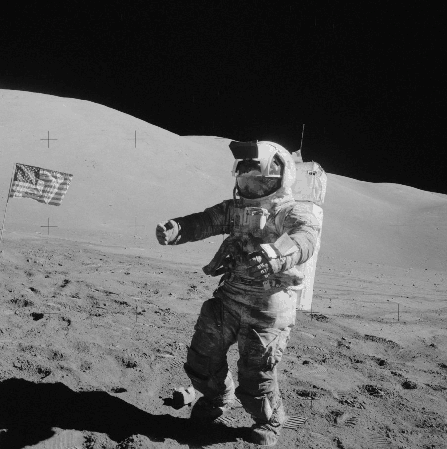 But, after all, we should not be surprised, for anything is possible on Apollo moon, and does not need a logical explanation. |